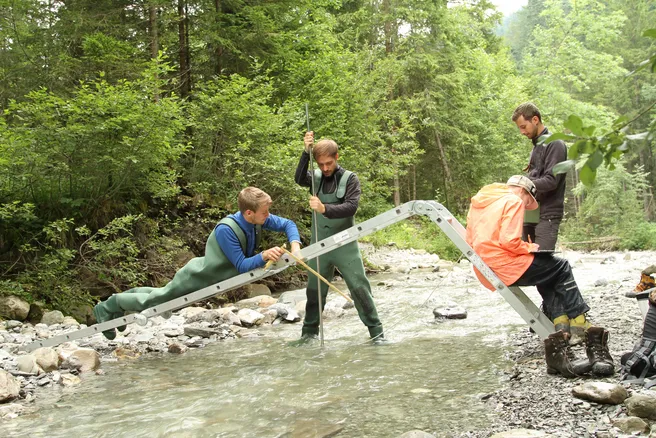For the first time after three years, the “Hydrological and Pedological Field Exercise” was able to take place in this summer semester. As the Chair of Hydrology and River Basin Management is lead by Prof. Markus Disse since one year, the field exercise, developed by Prof. Erwin Zehe, was now realized under new responsibility. Although the pattern of the module and the catchment area remained the same, it was adapted to current research topics of the chair.
The motivation for the field practice is to offer one of the rare opportunities during the Bachelor Studies to apply the theoretically gained knowledge about hydrology and field measurements practically in a small alpine region. This guaranties a deeper understanding of the topic because every participant is able take measurements by himself and thus gets to know very well how results are produced. In addition, advantages and disadvantages of each measurement method become clear under extreme conditions. Therefore, applications and examples are given, related to the theoretical background.
The catchment was taken out from the research project “Großhang” of Prof. Zehe. It is located in the Austrian federal state Vorarlberg, near Lake Constance With an area of 2 km2 the catchment is very small and situated at the edge of the Alps. Despite of the small area, all hydrological and pedological parameters were measured in close proximity to the accommodation.
The location of the catchment, an area with orographic rainfall events, which are induced by uprising air masses from the west, became evident during the field exercise. Within the first two days, precipitation depths of 50 mm per day were recorded. This long lasting constant rainfall event strained the participants as well as the measuring equipment. Even though these adverse conditions made great demand of everyone, it was the goal of the module to display the difficulties of measurements in the field, which was under these circumstances very memorable.
The “Ebniter Ache” and its inflows, where the discharge was measured in four different ways, shows a high sediment transport as well as a steep slope and a relatively small discharge and thus carries the characteristics of an Alpine torrent. Also, the complex geology of the area was inspected. Furthermore, the hydraulic conductivity, the soil moisture and the matrix potential were evaluated. At a meteorological station, the local and temporal variability of the weather was investigated. These measuring stations cover the most important issues of hydrology, soil science and meteorology.
The attending participants were selected randomly. Nevertheless, it was possible to consider almost all students. A strong motivation among all participants was consistently noticeable. Even though the heavy rainfall, it was attempted to perform all measurements and the data evaluation lasted partly until late at night.
The field exercise was not only a valuable practical experience for the students, but also an enrichment for the tutors and the chair members concerning their specific expertise.

